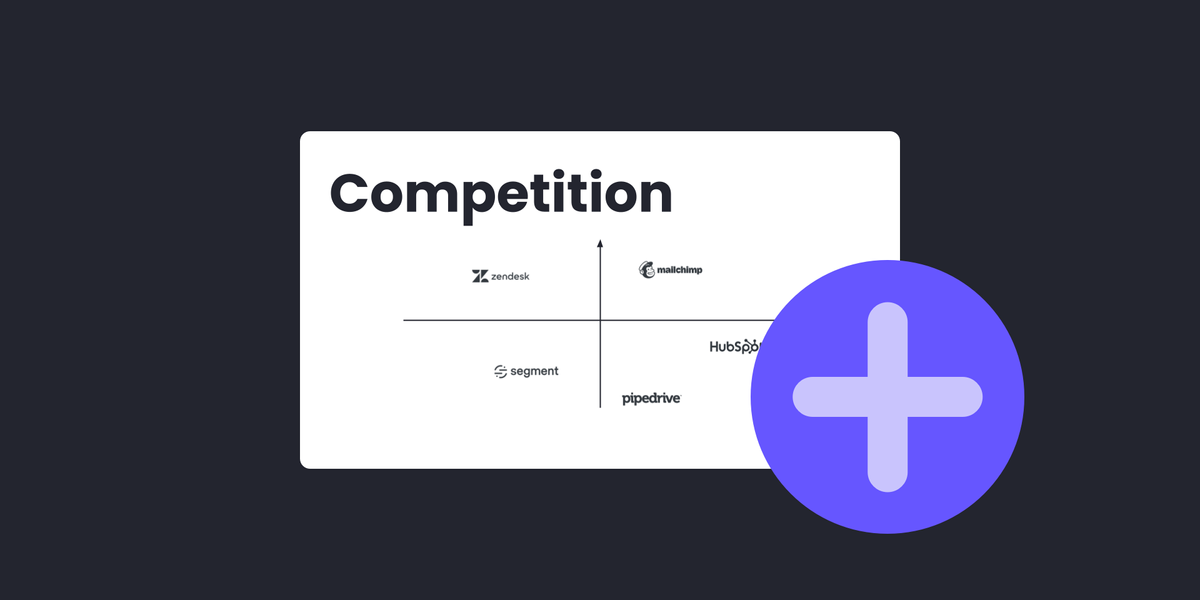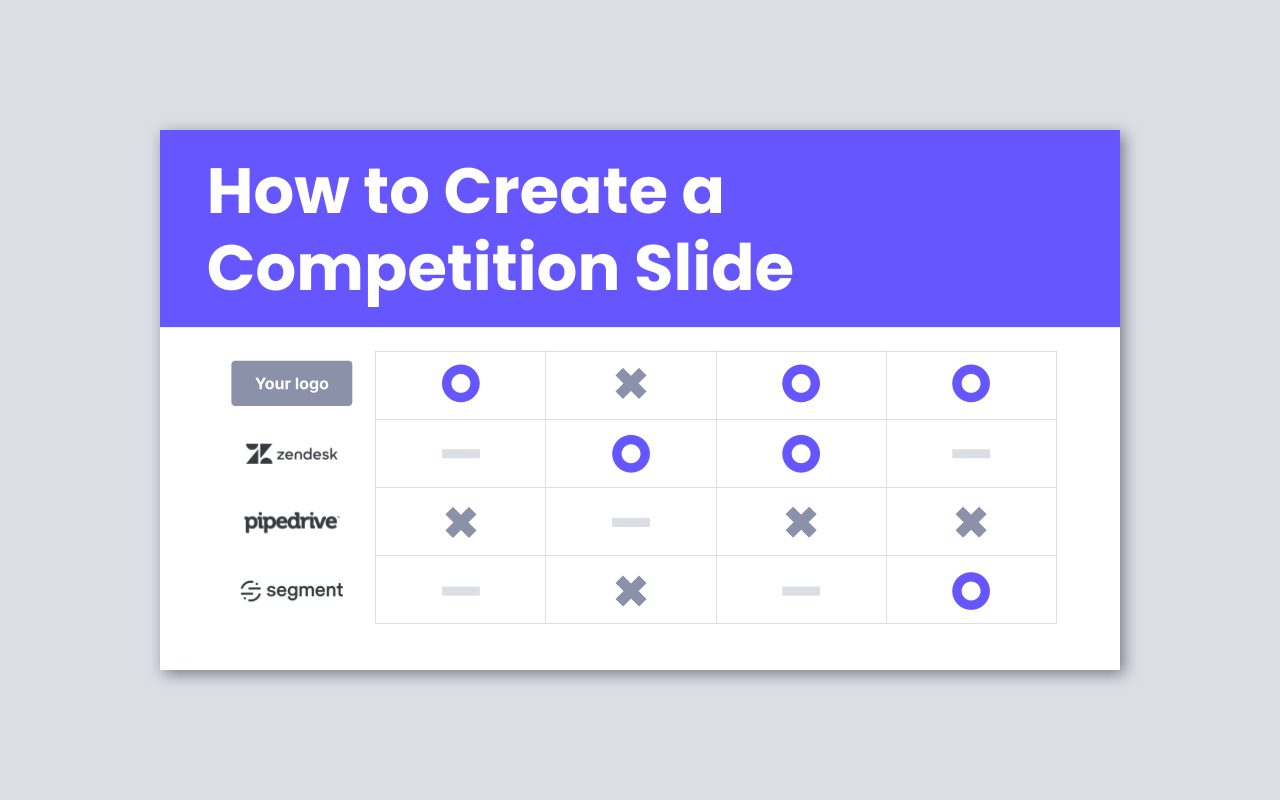How to Create a Competition Slide for Your Pitch Deck
A competition slide helps highlight your unique strengths and market position in a pitch deck. Learn how to create one effectively.

You walk into a pitch meeting, smile brightly, and declare, 'We have no competition!' Yeah, good luck with that. Investors might just politely show you the door, wondering if you've done your homework. A competition slide is a crucial part of your pitch deck that shows investors you understand the market landscape and have a solid plan to stand out among competitors. It's not about shying away from competition but embracing it as an opportunity to showcase your unique strengths. So, let's dive into why this slide matters and how to create one that will leave a lasting impression.
Why is the Competition Slide Important
The competition slide is essential because it highlights who's competing in your space, both directly and indirectly. It helps you articulate what makes your solution unique and showcases your differentiation factors. By acknowledging your competitors, you demonstrate a deep understanding of the market and a clear strategy to succeed. This slide is your chance to prove that your product or service offers something that others don't, making it a must-have for any successful pitch deck.

How to Create a Competition Slide
Describe the Competitive Landscape
To start, list all significant competitors in your market, including both direct and indirect ones. Understand how they are positioned within different market segments, such as demographics or psychographics. Evaluate each competitor's strengths, weaknesses, and market share to identify opportunities and challenges. This analysis will help you understand where you fit in and how you can outperform others.
Highlight Your Value Proposition and Positioning
Next, focus on the problems your target audience faces and how your solution addresses these issues more effectively than competitors. Use data to demonstrate how your product or service offers superior benefits, such as cost savings or increased efficiency. Craft a concise statement that communicates your unique position in the market and how it aligns with customer needs. This will help investors see why your solution is the best choice.
Visualization the Comparison
Finally, visualize the comparison between your product or service and competitors across key attributes like features, pricing, or user experience. You can use tools like quadrants to plot competitors based on criteria like market share and price, or create a comparison table to highlight your unique strengths. Use icons, colors, and concise text to make the comparison engaging and easy to understand. This visual approach will help investors quickly grasp your competitive advantages.
"To understand the startup's position in relation to competitors, the competitive landscape is examined. VCs assess a startup's ability to stand out from the crowd, gain market share, and perform better than or hold up against rival businesses. Startups with long-lasting competitive advantages are more likely to succeed in the long run." as Sujata Sangwan Rose once said on 8 Key Factors VCs Consider When Evaluating Startup Opportunities. Venture capitalists favor startups with sustainable competitive advantages that drive long-term success by outperforming competitors.
Mistakes to Avoid
Claiming There is No Competition
Claiming there is no competition can be a red flag for investors. It suggests either incomplete research or that the problem you're solving isn't significant enough to attract other players. Here are two examples:
- Bad Example: "Our product is so innovative that there are no competitors in the market." This statement raises concerns about the market's potential and your understanding of it.
- Good Example: "While there are no direct competitors, we face indirect competition from existing solutions. However, our unique approach offers superior benefits that set us apart." This approach shows awareness of the market and a clear strategy to succeed.
Putting All Competitors in a Bad Position
Badmouthing competitors can backfire by making you appear unprofessional or dishonest. Investors prefer a positive and constructive approach to competition. Here are two examples:
- Bad Example: "Our competitors are outdated and inefficient." This approach can come off as negative and unprofessional.
- Good Example: "While competitors offer strong solutions, our focus on customer service and innovation sets us apart and provides a better overall experience." This approach highlights your strengths without disparaging others.
Failing to Present Your Differentiation
Not clearly articulating how your product or service stands out from competitors can make your pitch less compelling. Investors want to see a clear competitive advantage that sets your business apart. Here are two examples:
- Bad Example: "We offer similar features to our competitors but at a slightly lower price." This doesn't clearly differentiate your product.
- Good Example: "Our unique algorithm and user-friendly interface provide faster results and a more intuitive experience compared to competitors, making us the preferred choice for customers." This clearly communicates your competitive advantage.
Frequently Asked Questions
What should my competition slide include?
Map out key competitors, their strengths/weaknesses, and use a chart or matrix to show how your startup stands out (price, tech, team, distribution, user love).
How honest should I be about competitors?
Acknowledge serious players, but focus on your unique advantages. Investors respect founders who understand the landscape and can articulate why their solution is better.
Do I need to list all competitors?
Only include those crucial for context; highlight your biggest direct and indirect competitors most relevant to your audience.
The Short of It
Competition is not a bad thing. In fact, good research on your competitors shows you truly understand your target market and helps investors feel confident about their buy-in. When you clearly map out the competitive landscape, you demonstrate that you know who you’re up against and have a smart plan to stand out. This understanding matters because investors want to see that you’re realistic, prepared, and ready to win in a competitive space. By including a competition slide that highlights your unique strengths without ignoring others, you build credibility and trust. If you want to create a pitch deck that speaks the language of investors and shows you’ve done your homework, why not start with our professional pitch deck template? It’s designed to help you tell that story clearly and confidently.

Get a Professional Pitch Deck and Tell Compelling Stories
✓ Unique layouts ✓ Editable elements ✓ Free vector icons ✓ Compatible with Google Slides
Download now →